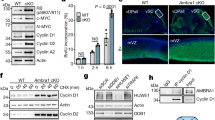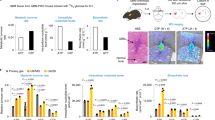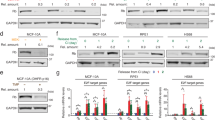Abstract
Retinoblastoma (Rb) protein is a tumor suppressor that is dysregulated in a majority of human cancers. Rb functions to inhibit cell cycle progression in part by directly disabling the E2F family of cell cycle-promoting transcription factors. Because the de novo synthesis of multiple glutamine-derived anabolic precursors is required for cell cycle progression, we hypothesized that Rb also may directly regulate proteins involved in glutamine metabolism. We examined glutamine metabolism in mouse embryonic fibroblasts (MEFs) isolated from mice that have triple knock-outs (TKO) of all three Rb family members (Rb-1, Rbl1 and Rbl2) and found that loss of global Rb function caused a marked increase in 13C-glutamine uptake and incorporation into glutamate and tricarboxylic acid cycle (TCA) intermediates in part via upregulated expression of the glutamine transporter ASCT2 and the activity of glutaminase 1 (GLS1). The Rb-controlled transcription factor E2F-3 altered glutamine uptake by direct regulation of ASCT2 mRNA and protein expression, and E2F-3 was observed to associate with the ASCT2 promoter. We next examined the functional consequences of the observed increase in glutamine uptake and utilization and found that glutamine exposure potently increased oxygen consumption, whereas glutamine deprivation selectively decreased ATP concentration in the Rb TKO MEFs but not the wild-type (WT) MEFs. In addition, TKO MEFs exhibited elevated production of glutathione from exogenous glutamine and had increased expression of gamma-glutamylcysteine ligase relative to WT MEFs. Importantly, this metabolic shift towards glutamine utilization was required for the proliferation of Rb TKO MEFs but not for the proliferation of the WT MEFs. Last, addition of the TCA cycle intermediate α-ketoglutarate to the Rb TKO MEFs reversed the inhibitory effects of glutamine deprivation on ATP, GSH levels and viability. Taken together, these studies demonstrate that the Rb/E2F cascade directly regulates a major energetic and anabolic pathway that is required for neoplastic growth.
This is a preview of subscription content, access via your institution
Access options
Subscribe to this journal
Receive 50 print issues and online access
$259.00 per year
only $5.18 per issue
Buy this article
- Purchase on Springer Link
- Instant access to full article PDF
Prices may be subject to local taxes which are calculated during checkout







Similar content being viewed by others
References
Hanahan D, Weinberg RA . Hallmarks of cancer: the next generation. Cell 2011; 144: 646–674.
Dang CV, Lewis BC, Dolde C, Dang G, Shim H . Oncogenes in tumor metabolism, tumorigenesis, and apoptosis. J Bioenerg Biomembr 1997; 29: 345–354.
Gillies RJ, Robey I, Gatenby RA . Causes and consequences of increased glucose metabolism of cancers. J Nucl Med 2008; 49 (Suppl 2): 24S–42S.
Moreno-Sanchez R, Rodriguez-Enriquez S, Marin-Hernandez A, Saavedra E . Energy metabolism in tumor cells. FEBS J 2007; 274: 1393–1418.
Warburg O, Negelein E . On the metabolism of cancer cells. Biochem Z 1924; 152: 319–344.
DeBerardinis RJ, Mancuso A, Daikhin E, Nissim I, Yudkoff M, Wehrli S et al. Beyond aerobic glycolysis: transformed cells can engage in glutamine metabolism that exceeds the requirement for protein and nucleotide synthesis. Proc Natl Acad Sci USA 2007; 104: 19345–19350.
Yuneva M, Zamboni N, Oefner P, Sachidanandam R, Lazebnik Y . Deficiency in glutamine but not glucose induces MYC-dependent apoptosis in human cells. J Cell Biol 2007; 178: 93–105.
Gao P, Tchernyshyov I, Chang TC, Lee YS, Kita K, Ochi T et al. c-Myc suppression of miR-23a/b enhances mitochondrial glutaminase expression and glutamine metabolism. Nature 2009; 458: 762–765.
Wise DR, DeBerardinis RJ, Mancuso A, Sayed N, Zhang XY, Pfeiffer HK et al. Myc regulates a transcriptional program that stimulates mitochondrial glutaminolysis and leads to glutamine addiction. Proc Natl Acad Sci USA 2008; 105: 18782–18787.
Le A, Lane AN, Hamaker M, Bose S, Gouw A, Barbi J et al. Glucose-independent glutamine metabolism via TCA cycling for proliferation and survival in B cells. Cell Metab 2012; 15: 110–121.
Metallo CM, Gameiro PA, Bell EL, Mattaini KR, Yang J, Hiller K et al. Reductive glutamine metabolism by IDH1 mediates lipogenesis under hypoxia. Nature 2011; 481: 380–384.
Mullen AR, Wheaton WW, Jin ES, Chen PH, Sullivan LB, Cheng T et al. Reductive carboxylation supports growth in tumour cells with defective mitochondria. Nature 2011; 481: 385–388.
Gaglio D, Soldati C, Vanoni M, Alberghina L, Chiaradonna F . Glutamine deprivation induces abortive s-phase rescued by deoxyribonucleotides in k-ras transformed fibroblasts. PLoS One 2009; 4 e4715.
Lora J, Alonso FJ, Segura JA, Lobo C, Marquez J, Mates JM . Antisense glutaminase inhibition decreases glutathione antioxidant capacity and increases apoptosis in Ehrlich ascitic tumour cells. Eur J Biochem 2004; 271: 4298–4306.
Seltzer MJ, Bennett BD, Joshi AD, Gao P, Thomas AG, Ferraris DV et al. Inhibition of glutaminase preferentially slows growth of glioma cells with mutant IDH1. Cancer Res 2010; 70: 8981–8987.
Dang CV, Le A, Gao P . MYC-induced cancer cell energy metabolism and therapeutic opportunities. Clin Cancer Res 2009; 15: 6479–6483.
Dang CV, O'Donnell KA, Zeller KI, Nguyen T, Osthus RC, Li F . The c-Myc target gene network. Semin Cancer Biol 2006; 16: 253–264.
Bensaad K, Tsuruta A, Selak MA, Vidal MN, Nakano K, Bartrons R et al. TIGAR, a p53-inducible regulator of glycolysis and apoptosis. Cell 2006; 126: 107–120.
Hu W, Zhang C, Wu R, Sun Y, Levine A, Feng Z . Glutaminase 2, a novel p53 target gene regulating energy metabolism and antioxidant function. Proc Natl Acad Sci USA 2010; 107: 7455–7460.
Matoba S, Kang JG, Patino WD, Wragg A, Boehm M, Gavrilova O et al. p53 regulates mitochondrial respiration. Science 2006; 312: 1650–1653.
Dannenberg JH, van Rossum A, Schuijff L, te Riele H . Ablation of the retinoblastoma gene family deregulates G(1) control causing immortalization and increased cell turnover under growth-restricting conditions. Genes Dev 2000; 14: 3051–3064.
Sage J, Mulligan GJ, Attardi LD, Miller A, Chen S, Williams B et al. Targeted disruption of the three Rb-related genes leads to loss of G(1) control and immortalization. Genes Dev 2000; 14: 3037–3050.
Takahashi C, Sasaki N, Kitajima S . Twists in views on RB functions in cellular signaling, metabolism and stem cells. Cancer Sci 2012; 103: 1182–1188.
Classon M, Harlow E . The retinoblastoma tumour suppressor in development and cancer. Nat Rev Cancer 2002; 2: 910–917.
Knudsen ES, Knudsen KE . Tailoring to RB: tumour suppressor status and therapeutic response. Nat Rev Cancer 2008; 8: 714–724.
Fuchs BC, Bode BP . Amino acid transporters ASCT2 and LAT1 in cancer: partners in crime? Semin Cancer Biol 2005; 15: 254–266.
Liu M, Liu H, Dudley SC . Reactive oxygen species originating from mitochondria regulate the cardiac sodium channel. Circ Res 2010; 107: 967–974.
Clem BF, Clem AL, Yalcin A, Goswami U, Arumugam S, Telang S et al. A novel small molecule antagonist of choline kinase-alpha that simultaneously suppresses MAPK and PI3K/AKT signaling. Oncogene 2011; 30: 3370–3380.
Kim JW, Gao P, Liu YC, Semenza GL, Dang CV . Hypoxia-inducible factor 1 and dysregulated c-Myc cooperatively induce vascular endothelial growth factor and metabolic switches hexokinase 2 and pyruvate dehydrogenase kinase 1. Mol Cell Biol 2007; 27: 7381–7393.
Wells J, Boyd KE, Fry CJ, Bartley SM, Farnham PJ . Target gene specificity of E2F and pocket protein family members in living cells. Mol Cell Biol 2000; 20: 5797–5807.
Liu Y, Costantino ME, Montoya-Durango D, Higashi Y, Darling DS, Dean DC . The zinc finger transcription factor ZFHX1A is linked to cell proliferation by Rb-E2F1. Biochem J 2007; 408: 79–85.
Dali-Youcef N, Mataki C, Coste A, Messaddeq N, Giroud S, Blanc S et al. Adipose tissue-specific inactivation of the retinoblastoma protein protects against diabesity because of increased energy expenditure. Proc Natl Acad Sci USA 2007; 104: 10703–10708.
Blanchet E, Annicotte JS, Lagarrigue S, Aguilar V, Clape C, Chavey C et al. E2F transcription factor-1 regulates oxidative metabolism. Nat Cell Biol 2011; 13: 1146–1152.
Hsieh MC, Das D, Sambandam N, Zhang MQ, Nahle Z . Regulation of the PDK4 isozyme by the Rb-E2F1 complex. J Biol Chem 2008; 283: 27410–27417.
Dannenberg JH, Schuijff L, Dekker M, van der Valk M, te Riele H . Tissue-specific tumor suppressor activity of retinoblastoma gene homologs p107 and p130. Genes Dev 2004; 18: 2952–2962.
McClellan KA, Vanderluit JL, Julian LM, Andrusiak MG, Dugal-Tessier D, Park DS et al. The p107/E2F pathway regulates fibroblast growth factor 2 responsiveness in neural precursor cells. Mol Cell Biol 2009; 29: 4701–4713.
Wang JB, Erickson JW, Fuji R, Ramachandran S, Gao P, Dinavahi R et al. Targeting mitochondrial glutaminase activity inhibits oncogenic transformation. Cancer Cell 2010; 18: 207–219.
Clem B, Telang S, Clem A, Yalcin A, Meier J, Simmons A et al. Small-molecule inhibition of 6-phosphofructo-2-kinase activity suppresses glycolytic flux and tumor growth. Mol Cancer Ther 2008; 7: 110–120.
Fan TW, Lane AN, Higashi RM, Yan J . Stable isotope resolved metabolomics of lung cancer in a SCID mouse model. Metabolomics 2011; 7: 257–269.
Dranka BP, Benavides GA, Diers AR, Giordano S, Zelickson BR, Reily C et al. Assessing bioenergetic function in response to oxidative stress by metabolic profiling. Free Radic Biol Med 2011; 51: 1621–1635.
Hill BG, Dranka BP, Zou L, Chatham JC, Darley-Usmar VM . Importance of the bioenergetic reserve capacity in response to cardiomyocyte stress induced by 4-hydroxynonenal. Biochem J 2009; 424: 99–107.
Perez J, Hill BG, Benavides GA, Dranka BP, Darley-Usmar VM . Role of cellular bioenergetics in smooth muscle cell proliferation induced by platelet-derived growth factor. Biochem J 2010; 428: 255–267.
Ciavarra G, Zacksenhaus E . Rescue of myogenic defects in Rb-deficient cells by inhibition of autophagy or by hypoxia-induced glycolytic shift. J Cell Biol 2010; 191: 291–301.
Acknowledgements
The authors gratefully acknowledge Jason Chesney, Sucheta Telang and John Eaton for their insightful discussions, and thank Tyler Jacks for the kind gift of the TKO MEFs. NMR experiments were carried out at the James Graham Brown Cancer Center NMR facility, supported in part by the Brown Foundation and NCCRR grant 1P20 RR18733. This work was supported by a Center of Biomedical Research Excellence in Molecular Targets (3P20RR018733-09-BFC) grant from the National Center for Research Resources and by RR024489 (BGH).
Author information
Authors and Affiliations
Corresponding author
Ethics declarations
Competing interests
The authors declare no conflicts of interest.
Additional information
Supplementary Information accompanies this paper on the Oncogene website
Rights and permissions
About this article
Cite this article
Reynolds, M., Lane, A., Robertson, B. et al. Control of glutamine metabolism by the tumor suppressor Rb. Oncogene 33, 556–566 (2014). https://doi.org/10.1038/onc.2012.635
Received:
Revised:
Accepted:
Published:
Issue Date:
DOI: https://doi.org/10.1038/onc.2012.635
Keywords
This article is cited by
-
Glutamine addiction in tumor cell: oncogene regulation and clinical treatment
Cell Communication and Signaling (2024)
-
Amino acid metabolism in tumor biology and therapy
Cell Death & Disease (2024)
-
SLC38A5 promotes glutamine metabolism and inhibits cisplatin chemosensitivity in breast cancer
Breast Cancer (2024)
-
Glutamate secretion by embryonic stem cells as an autocrine signal to promote proliferation
Scientific Reports (2023)
-
Regulation of tumor metabolism by post translational modifications on metabolic enzymes
Cancer Gene Therapy (2023)



